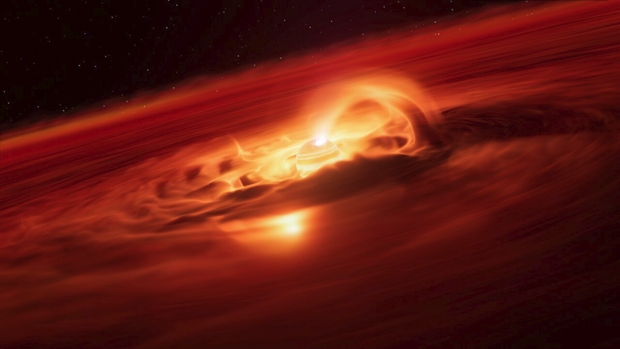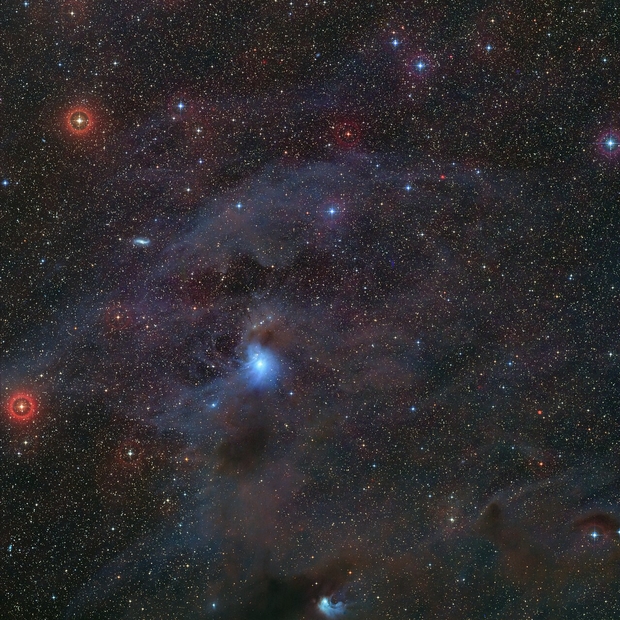How exoplanets emerge from circumstellar disks has always intrigued me, and many open questions remain, including the precise mechanisms behind the fast growth of gas giants. When the topic swings to so-called ‘rogue’ planets, formation issues seem to be the same, since we’ve assumed most such worlds have been ejected from a host system through gravitational interactions. But is there another formation path? We are learning that rogue planets are capable of feats not seen in conventional star/planet systems.
Research out of the National Institute for Astrophysics (INAF) in Italy is provocative. Using data from the European Southern Observatory’s Very Large Telescope (VLT) as well as the James Webb Space Telescope, Víctor Almendros-Abad (Astronomical Observatory of Palermo) and an international team of astronomers have found a large rogue planet (five to ten times as massive as Jupiter) that continues to form, accreting gas and dust from a surrounding cloud. No circumstellar disk required here. Growth comes in waves, now about eight times faster than just a few months before. We’re talking about accreting six billion tonnes per second, and a growth phenomenon hitherto restricted to young stars not yet on the Main Sequence.
Given this, we might consider Almendros-Abad’s comment an understatement:
“People may think of planets as quiet and stable worlds, but with this discovery we see that planetary-mass objects freely floating in space can be exciting places.”

Image: Astronomers have identified an enormous ‘growth spurt’ in a so-called rogue planet. Unlike the planets in our Solar System, these objects do not orbit stars, free-floating on their own instead. The new observations, made with the European Southern Observatory’s Very Large Telescope (ESO’s VLT), reveal that this free-floating planet is eating up gas and dust from its surroundings at a rate of six billion tonnes a second. This is the strongest growth rate ever recorded for a rogue planet, or a planet of any kind, providing valuable insights into how they form and grow. Credit: ESO.
The rogue planet in question is dubbed Cha 1107-7626, some 620 light years out in the direction of the constellation Chamaeleon. This is one of those deep southern sky constellations announced in the early 17th Century by Dutch navigators. How they ever found a chamaeleon shape in its dim stars is beyond me, but this niche of the sky holds, interestingly enough, one of the closest star-forming regions to the Sun. It is now home to what is considered the strongest accretion event on record for an object with the mass of a planet.
So we have an instance of a rogue planet that behaves in some respects like a star, with the current burst of accretion mediated by magnetic activity. Strong hydrogen alpha (Hα) emission picked up in the spectroscopic data is considered “a hallmark for channeled, magnetospheric accretion,” and the size of the change in the hydrogen lines is what flags the dramatic increase in accretion rate. Finding it in a planet-mass object is highly unusual. A major tool for astronomers, the hydrogen alpha line is emitted when an electron moves from the third lowest to the second lowest energy state in the hydrogen atom.
Looking into the paper (just published in The Astrophysical Journal Letters, I learned that bursts like this are well studied in young stars:
In particular, such events can have a significant effect on chemical and physical evolution of the disk (P. Ábrahám et al. 2009; S. A. Smith et al. 2025), and potentially on the early stages of planet formation. Our target is the lowest mass object observed thus far that is going through an accretion burst, and by far the lowest in the EXor category [young stars pre-Main Sequence]. Detailed studies of accretion variability have in the past helped to illuminate the interactions between young stellar objects and their disks, including the role of magnetic fields. Similarly, the observations presented here provide a glimpse into the nature of accretion in planetary-mass objects.

Image: This visible-light image, part of the Digitized Sky Survey 2, shows the position in the sky of the rogue planet Cha 1107-7626. The planet (not visible here) is located exactly at the centre of the frame. Credit: ESO/ Digitized Sky Survey 2.
The belief that rogue planets are invariably the result of ejections from a planetary system is challenged by these findings. From my reading of this paper, we seem to be looking at a ‘star-like’ formation of a gas giant through accretion, hinting at a variety of formation scenarios in free-floating worlds. Surely we will find more, but for now I can see why the authors call Cha1107-7626 “the poster child for disk accretion in the planetary-mass domain.”
The paper is Almendros-Abad et al., “Discovery of an Accretion Burst in a Free-Floating Planetary-Mass Object,” Volume 992, Number 1 (2 October 2025), L2 (full text).



An alternate source for the featured paper in this CD article:
https://www.eso.org/public/archives/releases/sciencepapers/eso2516/eso2516a.pdf
Discovery of an Accretion Burst in a Free-Floating Planetary-Mass Object
V. Almendros-Abad, Aleks Scholz, Belinda Damian, Ray Jayawardhana, Amelia Bayo, Laura Flagg, Koraljka Muˇzic´, Antonella Natta, Paola Pinilla, and Leonardo Testi
And this related recent paper:
https://arxiv.org/abs/2509.13513
Astrometric Methods for Detecting Exomoons Orbiting Imaged Exoplanets: Prospects for Detecting Moons Orbiting a Giant Planet in Centauri A’s Habitable Zone